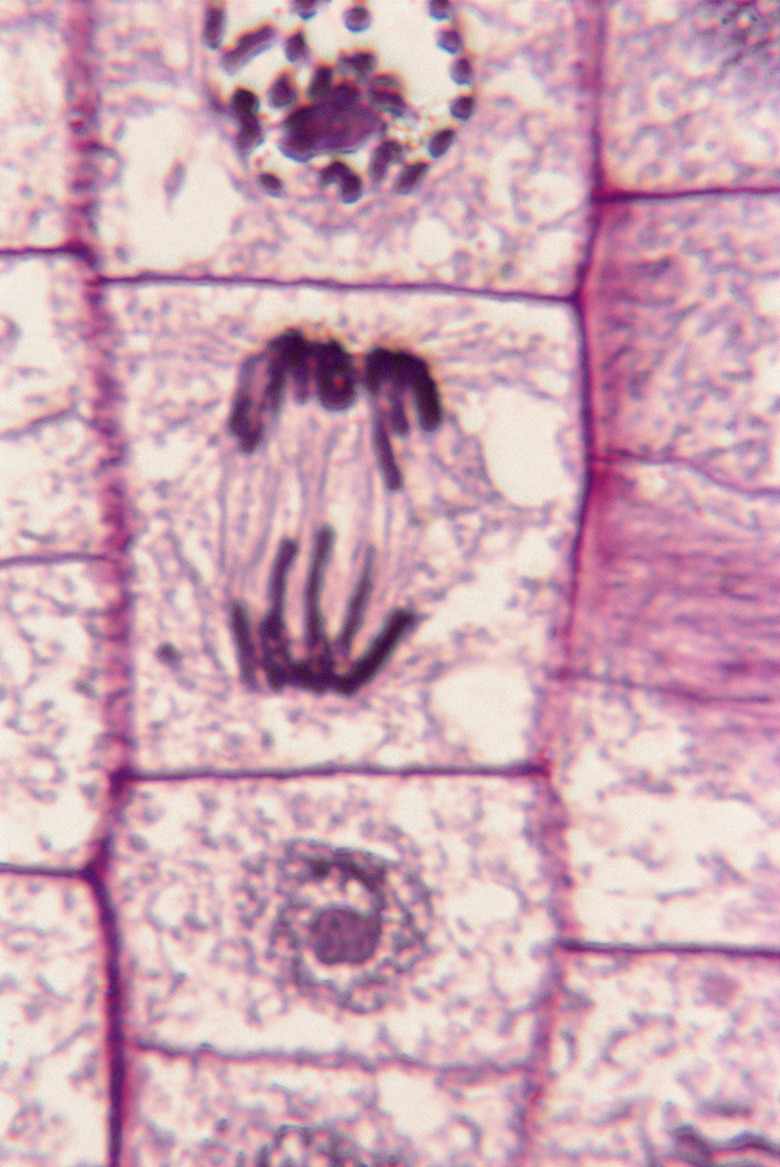What Kind Of Tissue Spends The Most Time In Interphase?
The cell cycle is made up of mitosis, which is when cells divide, and interphase, when cells grow, carry out specialized functions and prepare for mitosis.
Mitosis is a quick process that typically takes less than 20 percent of the cell's time, even for cells that divide frequently. Most other cells, such as nerve cells, liver cells, kidney cells and lung cells either divide very occasionally or not at all. The cells of these tissues spend most of their time in interphase or leave the cell cycle altogether.
Which Cells Divide and Why They Do
Which Cells Divide and Why They Do
The cells of higher organisms only divide and enter mitosis when there are special triggers. For example, in young organisms, tissues have to grow to reach full size. The cells keep dividing until the organism is mature and the tissues are fully grown.
Cells in the outer layers of the skin die and are sloughed off. As a result, skin cells keep dividing because the dead cells have to be replaced. Cells may also divide to repair the damage if tissues are injured. When such triggers don't exist, cells usually stay in interphase.
Whether cells enter mitosis depends on these triggers and on how specialized the cells are. Some cells have to change to carry out their functions and lose the ability to divide. For example, blood cells carry oxygen throughout the body. They don't have a nucleus, so they can no longer enter mitosis.
Other cells such as nerve cells become highly specialized and remain in interphase for the entire life of the adult organism. For tissues in which cells have changed to fulfill special functions, those cells spend most of their time in interphase.
The Stages of the Cell Cycle
The Stages of the Cell Cycle
The main parts of the cell cycle are interphase and mitosis. The three main phases of interphase are the following:
1. **G1 or Gap 1:** The cell grows and carries out its specialized functions. If it can no longer divide, it exits the cell cycle and enters the G0 stage. 2. **S or Synthesis:** The cell has received a signal triggering cell division and it makes copies of all its chromosomes. The cell will try to enter mitosis but the process could still be aborted. 3. **G2 or Gap 2:** The cell verifies that the DNA code of the chromosomes has been copied completely and correctly. It checks that all resources needed for mitosis are available.
Once the cell checks of G2 are completed successfully, the cell enters the actual cell division process of mitosis. The following are the main stages of mitosis:
1. **Prophase:** The nucleus dissolves and a spindle forms across the inside of the cell, anchored at opposite ends of the cell by two centrosomes. 2. **Metaphase:** The duplicated chromosomes line up along the middle of the spindle in the center of the cell. 3. **Anaphase:** The two copies of each chromosome migrate along the fibers of the spindle to opposite ends of the cell. 4. **Telophase and Cytokinesis:** The spindle dissolves and a cell nucleus reforms around the collection of chromosomes at each end of the cell. A cell dividing wall/membrane forms to make two new daughter cells.
Where in the Cell Cycle Cells Spend the Most Time
Where in the Cell Cycle Cells Spend the Most Time
Cells that don't divide spend their time in the G1 stage, which is a part of interphase. Cells that sometimes divide spend most of their time in the three interphase stages and quickly pass through mitosis for the occasional cell division.
Cells that divide often spend much of their time in the interphase S stage, preparing for mitosis. They may also spend a lot of time in the G2 stage if DNA has to be repaired or if additional enzymes or proteins are needed for successful mitosis.
The stages of mitosis are always short and can be completed quickly because the time-consuming preparations take place during the interphase stages S and G2. In mitosis, the cells that are created are identical copies of the parent cell. The two daughter cells enter the G1 stage to grow and take on their roles in their tissue.
Cite This Article
MLA
Markgraf, Bert. "What Kind Of Tissue Spends The Most Time In Interphase?" sciencing.com, https://www.sciencing.com/kind-tissue-spends-time-interphase-17996/. 28 June 2019.
APA
Markgraf, Bert. (2019, June 28). What Kind Of Tissue Spends The Most Time In Interphase?. sciencing.com. Retrieved from https://www.sciencing.com/kind-tissue-spends-time-interphase-17996/
Chicago
Markgraf, Bert. What Kind Of Tissue Spends The Most Time In Interphase? last modified March 24, 2022. https://www.sciencing.com/kind-tissue-spends-time-interphase-17996/
